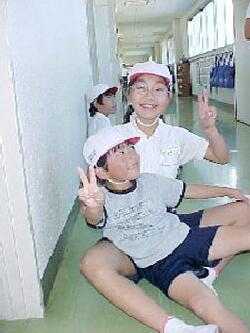
Japanese School Uniform: Activities--Cleaning the Schoool

Figure 1.--Japanese schools do no rely on janitors like American and European schools. The children themselves take responsibility for keeping their school clean. The children not only pick up litter and keep their classeooms neat and tidy, but they also sweep and scrubs the floors. With the cherry bloosms, the children here are doing a little spring housekeeing.
|
Japanese schools do not rely on janitors like American and European schools. The children themselves are expected to keep their school clean. We believe this is a very common approach at Japanese schools. The children not only pick up litter and keep their classrooms neat and tidy, but they also sweep and scrubs the floors. Not only does this keep Japanese schools clean but the children become responsible about their schools. Litter is never a problem at a Japanese school. The children begin to do this when they enter school the first day. Thus they accept it as a standard part of going to school. I believe this is done in most if not all Japanese primary schools. I am not entirely sure just how the Japanese schools do this. I believe that cleaning time is normally set aside each day at a Japanese school. We also notice the older children teaching the younger childer how to clean the schools (figure 1). I know this is done in primary schools as we see in the images here. I'm less sure about secondary schools. Hopefully our Japanese readers will tell us more.
Cleaning Schools
Japanese schools do not rely on janitors like American and European schools. The children themselves are expected to keep their school clean. Many students from an early age come to see cleaning their school clean as a duty.
Extent
We do not have any actual statistics, but We believe this is a very common approach at Japanese schools.
Activities
The children not only pick up litter and keep their classrooms neat and tidy, but they also sweep and scrubs the floors. This includes the classrooms abd the common areas like hallways. We also see them working on the grounds outdoors, picking up litter and raking leaves. We do not see the children using vacuum cleaners or other modern cleaning devices. Instead, we see them they use brooms, dust pans, and cloths. We note them scrubbing the floor on their hands abd knees. Everything seems to be done by hand. We assume that this is not because the schools can not afford equipment. It seems to be more a matter of the learning experience. Apparently authorities believe the hands-on experience will make more of an impression.
Impact
Not only does this keep Japanese schools clean but the children become responsible about their schools. Litter is thus never a problem at a Japanese school. Keeping their school clean is seen by Japanese educators as a very important lesson. It helps children get into the habit of keeping their environment clean. And there is very little litter at Japanese schools. Actually we don't seen much litter in public areas in general such as sidewalks and parks. Japanese educators want the children to take responsibility not only for their own classrooms, but for tghe common areas as well. They hope to make the pointv that the individual needs to learn to work for the good of the whole. Another factor is the value the Japanese place on cleanliness in general. One observer writes, "One of the most used adjectives in the Japanese language is kirei, a word that means both "beautiful" and "clean." Every language in the world has a word that means "beautiful," and all cultures value "beauty," however variously they may define it. And in the Japanese psyche, to be clean is to be beautiful; the concepts are linked socially as well as linguistically. (To be beautiful, of course, is not necessarily to be clean -- this distinction is linguistically accomplished by the use of words other than "kirei.")"

Figure 2.--Here a 6th grader is helping a 1st grader clean school during October 2003. Notice the chin straps on their caps.
|
School Level
The children begin to do this when they enter school the first day. Thus they accept it as a standard part of going to school. I believe this is done in most if not all Japanese primary schools. I know this is done in primary schools as we see in the images here. I'm less sure about secondary schools. Hopefully our Japanese readers will tell us more.
Approach
I am not entirely sure just how the Japanese schools do this. I believe that cleaning time is normally set aside each day at a Japanese school. We also notice the older children teaching the younger childer how to clean the schools (figure 2).
HBC-SU

Related Chronolgy Pages in the Boys' Historical Web Site
Late 19th century]
[The 1930s]
[The 1940s]
[The 1930s]
[The 1940s]
[The 1950s]
[The 1960s]
[The 1970s]
[The 1980s]
Navigate the Boys' Historical Clothing School Uniform Pages
[Main Japanese School Activities Page]
[Australia]
[England]
[France]
[Germany]
[Ireland]
[Italy]
[Japan]
[New Zealand]
[Scotland]
[United States]
Related Style Pages in the Boys' Historical Web Site
[Long pants suits]
[Short pants suits]
[Socks]
[Eton suits]
[Jacket and trousers]
[Blazer]
[School sandals]
Navigate the Boys' Historical Clothing Web Page
[Return to Main school uniform page]
[Introduction]
[Activities]
[Biographies]
[Chronology]
[Clothing styles]
[Countries]
[Bibliographies]
[Contributions]
[FAQs]
[Japanese glossary]
[Satellite sites]
[Tools]
[Boys' Clothing Home]
Created: 6:28 PM 11/11/2005
Last updated: 9:35 AM 12/7/2006





